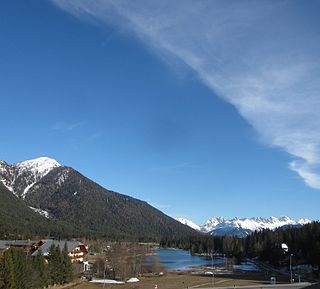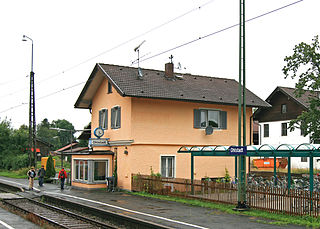
Seefeld in Tirol is an old farming village, now a major tourist resort, in Innsbruck-Land District in the Austrian state of Tyrol with a local population of 3,312. The village is located about 17 km (11 mi) northwest of Innsbruck on a plateau between the Wetterstein mountains and the Karwendel on a historic road from Mittenwald to Innsbruck that has been important since the Middle Ages. It was first mentioned in 1022 and since the 14th century has been a pilgrimage site, benefiting not only from the visit of numerous pilgrims but also from its stacking rights as a trading station between Augsburg and the Venice. Also since the 14th century, Tyrolean shale oil has been extracted in the area. Seefeld was a popular holiday resort even before 1900 and, since the 1930s, has been a well known winter sports centres and amongst the most popular tourist resorts in Austria. The municipality, which has been the venue for several Winter Olympics Games, is the home village of Anton Seelos, the inventor of the parallel turn.

Innsbruck Hauptbahnhof is the main railway station in Innsbruck, the capital city of the Austrian federal state of Tyrol. Opened in 1853, the station is a major hub for western and central Austria. In 2019, it was the 8th-busiest station in the country, and the 2nd-busiest outside of Vienna after only Linz Hauptbahnhof, with 315 train movements and 38,500 passengers daily.

The Wetterstein mountains, colloquially called Wetterstein, is a mountain group in the Northern Limestone Alps within the Eastern Alps, crossing the Austria–Germany border. It is a comparatively compact range located between Garmisch-Partenkirchen, Mittenwald, Seefeld in Tirol and Ehrwald along the border between Germany (Bavaria) and Austria (Tyrol). Zugspitze, the highest peak is at the same time the highest mountain in Germany.

The Munich–Garmisch-Partenkirchen railway is a single track, electrified main line railway in the southern part of the German state of Bavaria. It runs from Munich via Starnberg and Murnau to Garmisch-Partenkirchen. The first part of it was opened in 1854 and is one of the oldest lines in Germany.

The Ausserfern Railway is a cross-border railway line in the German state of Bavaria and the Austrian state of Tyrol. The single-tracked branch line starts from Kempten in Germany, before crossing into Austria just after passing through Pfronten. It then transits the Außerfern area around Reutte, before passing back into Germany in order to terminate at Garmisch-Partenkirchen.

Garmisch-Partenkirchen station is a junction station in the German State of Bavaria. It is the biggest station in Garmisch-Partenkirchen. It has five platform tracks and is classified by Deutsche Bahn as a category 3 station. The station has about 50 services daily operated by DB Regio and some long-distance services operated by Deutsche Bahn. It is on the lines connecting Munich and Garmisch-Partenkirchen, Garmisch-Partenkirchen and Innsbruck and Garmisch-Partenkirchen and Reutte.

The Karwendel is an international named express train service between Germany and Austria. The train was named after the Karwendel mountain range forming the German-Austrian border south of Garmisch-Partenkirchen, which it passes on the Mittenwald Railway (Karwendelbahn). Introduced in 1930, it is currently labelled as an Intercity-Express train connection operated by Deutsche Bahn AG.

Weilheim (Oberbay) station is the station of the Bavarian district town of Weilheim in Oberbayern. It is a crossing station on the Munich–Garmisch-Partenkirchen railway, the Ammersee Railway from Mering and the Weilheim–Peißenberg railway. It is classified by Deutsche Bahn as a category 4 station and has five platform tracks. It is served by about 100 trains daily operated by Deutsche Bahn and Bayerische Regiobahn (BRB).

E 533 is a European B class road in Germany and Austria, connecting the cities Munich — Garmisch-Partenkirchen — Mittenwald — Seefeld in Tirol — Innsbruck.

The Erlspitze Group, also called the Seefeld Group, is the southwesternmost side range of the Austrian part of the Karwendel mountains in the Alps. It forms a horseshoe-shaped highland around the valley of Eppzirler Tal and is joined in the south to the Nordkette by the Erl Saddle (Erlsattel) near Solsteinhaus. It is bounded in the west by the Seefeld Basin, in the east by the valleys of the Gleirschtal and the Großes Kristental; its forested northern foothills reach as far as Scharnitz.

The Scharnitz Pass is a narrow section of the upper Isar valley in the Northern Limestone Alps. It lies at a height of about 955 m on the Austro-German border between the states of Bavaria and Tyrol. Its name derives from the village of Scharnitz immediately to the south.

The Zirler Berg near Zirl in the Austrian federal state of Tyrol is a mountain, 1,057 m (AA) high, in the Karwendel Alps, a western part of the Northern Limestone Alps. It is a southern foothill of the Reither Spitze (2,374 m) and is known mainly because the Seefelder Straße (B 177) on its southern slopes climbs through 388 metres in a distance of less than 4 kilometres from Zirl in the Inn valley to Leithen on the Seefeld Plateau.

The Seefeld Saddle is a saddle and mountain pass, 1,185 m (AA), in the Northern Limestone Alps in the Austrian federal state of Tyrol. Two major transport routes run over it: the Seefelder Straße (B 177) and the Mittenwald Railway. On the Seefeld Plateau north of the saddle lies the village and ski resort of Seefeld in Tirol.

Mittenwald station is a railway station in the German State of Bavaria, in the town of Mittenwald. It has three platform tracks and is classified by Deutsche Bahn (DB) as a category 4 station.

Eschenlohe station is a railway station in the municipality of Eschenlohe, in the Garmisch-Partenkirchen district in Bavaria, Germany. It is located on the Munich–Garmisch-Partenkirchen railway of Deutsche Bahn.

Innsbruck Hötting railway station is a railway station in the borough of Hötting in Innsbruck, the capital city of the Austrian state of Tyrol. It is the first station on the Mittenwald Railway (Karwendelbahn) north of Innsbruck West station, where the line branches off the Arlberg railway. The station was opened in 1912 and is served by trains operated by both Deutsche Bahn and Austrian Federal Railways (ÖBB).

Huglfing station is a railway station in the municipality of Huglfing, in Bavaria, Germany. It is located on the Munich–Garmisch-Partenkirchen railway of Deutsche Bahn.

Uffing am Staffelsee station is a railway station in the municipality of Uffing am Staffelsee, in Bavaria, Germany. It is located on the Munich–Garmisch-Partenkirchen railway of Deutsche Bahn.

Ohlstadt station is a railway station in the municipality of Ohlstadt, in Bavaria, Germany. It is located on the Munich–Garmisch-Partenkirchen railway of Deutsche Bahn.

Farchant station is a railway station in the municipality of Farchant, in Bavaria, Germany. It is located on the Munich–Garmisch-Partenkirchen railway of Deutsche Bahn.

























